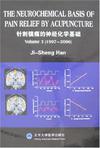针刺镇痛的神经化学基础 Volume 3
出版时间:2008-1 出版社:北京大学医学出版社 作者:韩济生 编 页数:672
Tag标签:无
内容概要
《针刺镇痛的神经化学基础(Volume 3)(1997-2006)》把最近10年(1987—1997年)来取得的科研成果加以系统整理,用英文发表,希望有助于增进医学界和生物学界对针刺镇痛原理的了解,这一项努力的目的不仅在于促进针灸的临床应用,更希望能吸引更多学者投入这一研究,必然会发现更多的可用于针刺疗法的适应症。药物依赖,特别是海洛因成瘾,很可能是这些适应症之一。
书籍目录
1 OVERVIEW 1.1 Acupuncture activates endogenous systems of analgesia 1.2 Acupuncture anesthesia (AA) versus acupuncture-assisted anesthesia (AAA) 1.3 Electroacupuncture: mechanisms and clinical application 1.4 Acupuncture research & neuroscience development 1.5 Traditional and evidence-based acupuncture: history, mechanisms, and present status 1.6 Opioid and antiopioid peptides: a model of Yin-Yang balance in acupuncture mechanisms of pain modulation 1.7 Acupuncture: neuropeptide release produced by electrical stimulation of different frequencies 1.8 Heritability of nociception. HI. Genetic relationships among commonly used assays of nociception and hypersensitivity 1.9 The effect of genotype on sensitivity to electroacupuncture analgesia2 PEPTIDE AND NON-PEPTIDE OPIOID AGONIST 2.1 Discrimination between peptide and non-peptide opioid agonists on the transcription of opioid receptors in two cell lines 2.2 Inhibition of the transcription of u opioid receptor by long-term exposure of SHSY5Y cell line to peptide and non-peptide opioid agonists 2.3 The metabolic evidence of synergistic effect between ohmefentanyl and [D-Pen2, D-PenS]enkephalin on differentiated SH-SY5Y cells in humans 2.4 The metabolic evidence of synergistic interaction between DAMGO and DPDPE on undifferentiated SH-SY5Y cells3 ACUTE PAIN 3.1 Endomorphin-1 mediates 2 Hz but not 100 Hz electroacupuncture analgesia in the rat 3.2 Endomorphin and u-opioid receptors in mouse brain mediate the analgesic effect induced by 2 Hz but not 100 Hz electroacupuncture stimulation 3.3 Acupuncture and endorphins 3.4 Effects of synchronous or asynchronous electroacupuncture stimulation with low versus high frequency on spinal opioid release and tail flick nociception 3.5 Decreased dynorphin A ( 1-17 ) in the spinal cord of spastic rats after the compressive injury 3.6 Involvement of ionotropic glutamate receptors in low frequency electroacupuncture analgesia in rats 3.7 Characteristics of electroacupuncture-induced analgesia in mice: variation with strain, requency, intensity and opioid involvement .. 3.8 Relations between brain network activation and analgesic effect induced by low vs. high frequency electrical acupoint stimulation in different subjects: a functional magnetic resonance imaging study 3.9 Modulation of cold pain in human brain by electric acupoint stimulation: evidence from MRI 3.10 Evidence from brain imaging with fMRI supporting functional specificity of acupoints in humans 3.11 Modulation of pain signal processing by electric acupoint stimulation: an electroencephalogram study 3.12 Parallel pain processing in freely moving rats revealed by distributed neuron recording 3.13 Nociceptive responses of anterior cingulate cortical ensembles in behaving rats 3.14 Differential modulation of nociceptive neural responses in medial and lateral pain pathways by peripheral electrical stimulation: a multichannel recording study the analysis of cerebral evoked potentials 3.15 Sliding-window technique for 3.16 Coding of peripheral electrical stimulation frequency in thalamocortical pathways 3.17 A controlled study to evaluate the analgesic effect of transcutaneous electric nerve stimulation on post-operative pain in patients of cardiac operation: patient-controlled analgesia as the evaluation criterion4 CHRONIC PAIN 4.1 Decreased GDNF mRNA expression in dorsal spinal cord of unilateral arthritic rat 4.2 Glial cell line-derived neurotrophic factor contributes to delayed inflammatory hyperalgesia in adjuvant rat pain model 4.3 Change of vanilloid receptor 1 expression in dorsal root ganglion and spinal dorsal horn during inflammatory nociception induced by complete Freund' s adjuvant in rats 4.4 Attenuation of mechanical but not thermal hyperalgesia by electroacupuncture with the of opioids in rat model of chronic inflammatory pain involvement 4.5 Repeated 100 Hz TENS for the treatment of chronic inflammatory hyperalgesia and suppression of spinal release of substance P in monoarthritic rats 4.6 Repeated administration of low dose ketamine for the treatment of monoarthritic pain in the rat 4.7 Ketamine potentiates the effect of electroacupuncture on mechanical allodynia in a rat model of neuropathic pain 4.8 Suppression of neuropathic pain by peripheral electrical stimulation in rats: &-opioid receptor and NMDA receptor implicated 4.9 Hyperpolarization-activated, cyclic nucleotide-gated cation channels: roles in the differential electrophysiological properties of rat primary afferent neurons 4.10 Ectopic discharges from injured nerve fibers are highly correlated with tactile aUodynia only in early, but not late, stage in rats with spinal nerve ligation 4.11 Inhibition ofhyperpolarization-activated current by ZD7288 suppresses ectopic discharge of injured dorsal root ganglion neurons in a rat model of neuropathic pain 4.12 Dynamic neuronal responses in cortical and thalamic areas during different phases of formalin test in rats……5 ANTI-OPIOID PEPTIDES AND OPIOID TOLERANCE6 DRUG DEPENDENCE7 PARKINSION'S DISEASE8 OBESITYAPPENDIX 1 Source of PaperAPPENDIX 2 Acupuncture research is part of my life
图书封面
图书标签Tags
无
评论、评分、阅读与下载
用户评论 (总计1条)
- 这是一本关于针刺的神经化学基础研究的论文集,不仅仅只有镇痛的研究,还有对于药物依赖,帕金森病,肥胖的针刺神经化学基础研究等。无论它离针灸效应研究的终极有多远,都是力图对针灸进行现代科学表述的一种尝试,也展示了关于针刺的神经化学基础研究的工作和进展,对针刺基础研究工作者是一本有价值的书。书是英文版的。
推荐图书
- 物权法典型案例评析
- 厦门民营经济发展报告
- 水电开发与绿色未来新华论坛论文集
- Flash CS3网站商业设计从入门到精通
- 劳动争议调解仲裁法条文讲解与案例分析
- 中国-欧盟
- 臂架式起重机安全技术
- 造型设计完美风暴
- 药物化学
- 新编Windows XP中文版从入门到精通
- 新编外行学电脑从入门到精通
- 新编PowerPoint 2003中文版从入门到精通
- 2008护理学(中级)
- ABAQUS6.6基础教程与实例详解
- 大众传播理论
- 精细化学品化学
- 物权法原理精要与实务指南
- 角膜接触镜并发症及处理
- 建筑涂料配方手册
- 刘梁经-写意马牛
- 劳动争议调解仲裁法简明实用问答221问
- 先进树脂基复合材料
- 中国资本市场发展报告
- 新编Office 2007三合一高效办公入门提高与技巧
- IT项目管理案例与分析
相关图书
- 建筑外立面速查手册
- 英国金三角企业家的秘密To The Edge
- 在线购物指南2008 The Shopaholic's Guide to Buying Online 2008
- 具有权威性的求职书The Definitive Job Book
- 3ds maxa总动员工业产品建模篇
- 中药新剂型与新技术
- 全国卫生专业技术资格考试丛书
- 品牌的建立Never Mind the Sizzle...Where's the Sausage?
- 人生的黄金入场券Life's Golden Ticket
- 与工作相关联的127问答Where Do All the Paperclips Go?
- Office2003商务办公好帮手-(附光盘)
- 景观设计基础
- 企业教练所承担的义务Coaching For Commitment
- 英语口语有救了
- 山西省岩溶泉域水资源保护
- 近代印坛点将录
- 如何在线购买华丽的礼物Shopaholic's Guide to Buying Gorgeous Gifts Online
- 永远的怀念
- 吴孙权书法艺术
- 建
- CCENT/CCNA ICND 1认证考试指南
- 水工建筑物
- 塑料混合及连续混合设备
- 青铜时代
- Flash ActionScript 3.0动画教程
